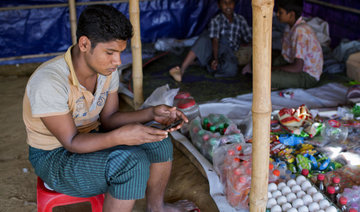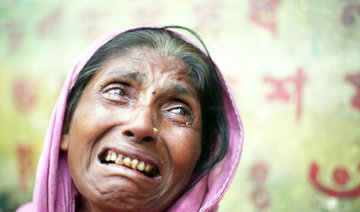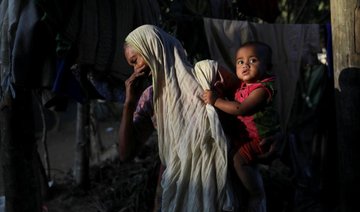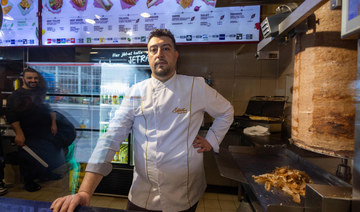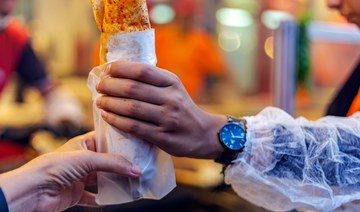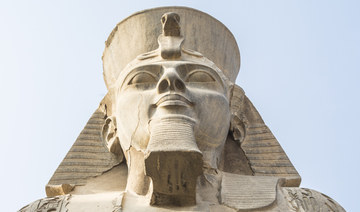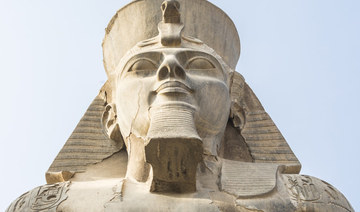THETKABYIN, Myanmar: In her dreams, Setara walks hand in hand with her Muslim husband through the streets of the seaside Myanmar town they grew up in. They visit old friends, share a meal with family, dip their toes into the warm surf of the Bay of Bengal.
But in the hate-filled reality of the world they live in, Setara can only do these things alone — when she takes off her Islamic veil and crosses through a pair of checkpoints into the predominantly Buddhist state capital, where her government will not allow the love of her life to set foot.
That’s because Setara’s husband is an ethnic Rohingya Muslim, a group the UN has called one of the most persecuted on the planet. Setara, meanwhile, was born a Buddhist and part of the ethnic Rakhine, who despise the Rohingya and see them as foreign invaders from Bangladesh.
Marriage between the two communities is extraordinarily rare. It’s also risky in a nation where security forces have driven more than 730,000 Rohingya into exile since 2016, carried out large-scale massacres and burned hundreds of villages in a campaign the UN and human rights groups have described as “ethnic cleansing.”
In Sittwe, Setara tells no one she is married to a Rohingya. Because “if they knew, they would kill me right away. So I’m always careful.”
The 24-year-old’s fears are not exaggerated. Even Rohingya who have ventured into Sittwe on rare trips escorted by police in recent months have been attacked by mobs and killed. Hard-line Buddhists regularly march through the city’s crumbling streets, past ruined mosques that have been closed since June 2012, when the Rakhine burned most Rohingya homes and drove more than 120,000 into camps for the displaced.
Setara, then a widow, met her husband, Mohammad, about eight months later at a market on the edge of a Rohingya village where she had come to sell vegetables. Rakhine traders, who can travel freely, regularly sell goods to Rohingya at marked-up prices.
They exchanged phone numbers and she began visiting him at a pharmacy he ran nearby. Mohammad, 32, bought her small gifts, teased her to make her laugh and took her for rides on his motorbike. He was amazed to meet a Rakhine woman who didn’t treat a Rohingya any differently than her own. He told her he loved her.
Setara felt the same way. She thought he was the kindest man she had ever known.
But when she told her family — after much reluctance — that she was dating a Rohingya man, they became enraged. Her brother beat her severely. They told her she could not go back. Then, her family kicked her out.
The move pushed her closer to Mohammad. In late 2013, she converted to Islam and they married in a small Islamic ceremony held before local religious leaders. No one from Setara’s family attended.
In the years since, Setara has reconciled with her three sisters. But she has never been able to return home. Her parents passed away when she was young, and the brother who helped raise them all still refuses to speak to her. Residents of her old neighborhood have also made clear she is no longer welcome; they call her a “Kalar’s wife.” Kalar is a derogatory word for Muslims that is frequently used in Myanmar.
Mohammad characterizes their relationship in much the same way his wife does. “She sees me as a human being and I see her as a human being, and it’s that simple,” he said, when asked how they had overcome the huge societal obstacles to marry.
Mohammad is a quiet man with a calm manner; Setara is more outspoken. They are a couple clearly in love, glancing at each other and smiling as they talk. The AP is identifying them by their first names only for their protection.
They live in a Rohingya village adjacent to a network of Muslim displaced camps, with Setara’s 2-year-old niece and her 9-year-old daughter from her first marriage. Setara says the Rohingya have welcomed her warmly, as one of their own. But she misses her old friends and her old life.
While Mohammad, like all Rohingya, is not permitted by the government to travel, Setara makes regular trips to Sittwe, about half an hour away, to buy supplies for the small pharmacy and shop they run beside their home.
Before going, though, she smears a pale cosmetic paste on her cheeks called “thanaka,” which is commonly used by Buddhists in Myanmar. She takes off her veil and puts on a blouse. And she never forgets to bring her national identification card, which includes a critical line indicating she is Buddhist. Without it, she could never cross the checkpoints — one manned by police, the other by soldiers — to town.
The contrast between the two worlds is startling. The Rohingya side is dry and dusty, devoid of trees and filled with despair, with little to do. The Buddhist side is lush, with schools and a university, paved roads, a karaoke bar and restaurants that serve wine by the sea.
In Sittwe’s main market, Setara visits friends and sometimes her sisters. But she also overhears Rakhine gossiping about the latest news, and cursing the Rohingya.
Sometimes she goes to the beach, where teens hang out at seaside cafes on plastic chairs, and watches the sun go down. But when she thinks about her husband — the fact that he cannot be there — her thoughts turn dark, and she wonders “if our lives will just end like this.”
“I always wish I could go out with my husband and go to the fun places in town ... especially when I see other couples going around,” Setara said. “I just want to cry sometimes.”
Mohammad imagines the same, impossible trips. But he also worries each time she goes. “I worry something might happen, that someone might find out she’s a Muslim, that she’s married to me,” he said.
Both said they want children of their own because they love each other. But they know it would not be easy for a child, who would be half Rohingya and not recognized as a Burmese citizen.
The marriage has given Setara a profound insight into life in the camps for the Rohingya displaced.
“It’s just like hell,” she said. “They have no hope. They have no medical treatment. People are more and more scared.”
Since Rohingya insurgents staged dozens of attacks in the northern half of Rakhine state that triggered a major backlash by security forces in late August, life in the south, where Setara and her husband live, has stayed calm but only gotten harder.
International aid for displaced camps has been held up by authorities, and humanitarian workers have been forced to scale back visits. Hussein said the government has also stopped Rohingya from fishing, a critical source of income, until they accept “national verification cards” which identify them as “Bengalis.” Many have resisted because they insist on being identified as Rohingya, a term the government does not recognize.
In her despair, Setara sometimes tells her husband she is going to leave. When he begs her to “stop saying that,” she tells him she doesn’t mean it.
“It doesn’t mean that I don’t love him. I just don’t like the way we have to live here,” she said. “I keep telling myself every day that I need to be strong .... but sometimes I just want to fly away.”
Still, she says, that is something she will never do. “The future for the Rohingya is bad,” she said. “But I will never leave ... it is my destiny to be here, to be with my husband.”
In strife-torn Myanmar, love trumps hate for a rare couple
In strife-torn Myanmar, love trumps hate for a rare couple
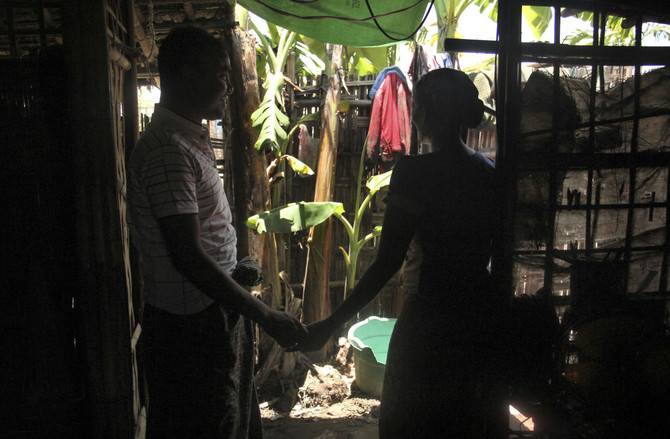
China’s Shenzhou-18 mission docks with space station

- The astronauts took off from the Jiuquan Satellite Launch Center in China’s northwest at 8:59 p.m. local time Thursday
- The astronauts will stay at the Tiangong space station for six months, carrying out experiments
JIUQUAN, China: A spaceship carrying three astronauts from China’s Shenzhou-18 mission safely docked at Tiangong space station Friday, state-run media reported, the latest step in Beijing’s space program that aims to send astronauts to the Moon by 2030.
The crew took off in a capsule atop a Long March-2F rocket from the Jiuquan Satellite Launch Center in China’s northwest at 8:59 p.m. local time 1259 GMT) Thursday.
By early Friday the spacecraft had “successfully docked” with the space station, state-run news agency Xinhua reported, citing the China Manned Space Agency.
The mission is led by Ye Guangfu, a fighter pilot and astronaut who was previously part of the Shenzhou-13 crew in 2021.
He is joined by astronauts Li Cong and Li Guangsu, who are heading into space for the first time.

Onlookers cheered as the rocket blasted off into the night sky, an AFP journalist at the scene said.
Xinhua said the launch had been declared a “complete success.”
The astronauts will stay at the Tiangong space station for six months.
There they plan to carry out experiments “in the fields of basic physics in microgravity, space material science, space life science, space medicine and space technology,” the China Manned Space Agency has said.
They will also try and create an aquarium onboard and seek to raise fish in zero gravity, according to Xinhua.
“Not only will the taikonauts find joy in the space ‘aquarium,’ but it may also pave the way for their future counterparts to enjoy nutritious fish from their own in-orbit harvests,” it added.

They will also conduct experiments on “fruit flies and mice,” a researcher quoted by the agency said.
The new crew will replace the Shenzhou-17 team, who were sent to the station in October.
Plans for China’s “space dream” have been put into overdrive under President Xi Jinping.
The world’s second-largest economy has pumped billions of dollars into its military-run space program in an effort to catch up with the United States and Russia.
Beijing also aims to send a crewed mission to the Moon by 2030, and plans to build a base on the lunar surface.
China has been effectively excluded from the International Space Station since 2011, when the United States banned NASA from engaging with the country — pushing Beijing to develop its own orbital outpost.
That station is the Tiangong, which means “heavenly palace” — the crown jewel of a space program that has landed robotic rovers on Mars and the Moon, and made China the third country to independently put humans in orbit.
It is constantly crewed by rotating teams of three astronauts, with construction completed in 2022.
The Tiangong is expected to remain in low Earth orbit at between 400 and 450 kilometers (250 and 280 miles) above the planet for at least 10 years.
Algeria’s first KFC restaurant reopens without logo following Gaza protests

- Protesters gathered outside outlet last week in solidarity with Palestinians
- KFC parent company Yum! Brands has faced backlash for its ties with Israel
LONDON: Algeria’s first Kentucky Fried Chicken outlet has resumed operations after a temporary closure prompted by a series of pro-Palestinian demonstrations last week.
However, the restaurant, situated in the Algiers suburb of Dely Ibrahim, reopened its doors without the familiar Col. Sanders logo on its exterior.
It remains unclear if the outlet has had a change of ownership or remains under the umbrella of Yum! Brands, the parent company of KFC.
Demonstrators gathered outside the eatery on April 16, calling for a boycott and expressing solidarity with Palestinians amid the Gaza conflict.
Protesters draped in Palestinian flags voiced support for “Palestinian martyrs” while obstructing access to the storefront.
The restaurant has faced a backlash due to its perceived ties to Israel, with Yum! Brands having made investments in Israeli startups, including TicTuk, a company that allows customers to order food on social networks and message apps, and Dragontail, a system software company specializing in food processing.
In response, the Boycott, Divestment, Sanctions movement designated KFC’s sister company, Pizza Hut, as an “organic boycott target,” due to the “brands’ complicity in Israel’s genocide and apartheid against Palestinians.”
بعد أيام من افتتاح فرعها الأول، KFC الجزائر تزيل شعار علامتها وتُغلق أبوابها!
— أحمد داود (@AhmadDaoud14) April 17, 2024
منذ افتتاحها تعالت أصوات مقاطعتها، ووقفات احتجاجية أمامها، واستنكارٌ لمنح الترخيص لوكيلها! #الجزائر
pic.twitter.com/rIaOG80xTi
While the temporary closure of the KFC outlet was hailed as a success by demonstrators, its reopening sparked disappointment among some Algerians.
The incident underscores challenges and employment ramifications stemming from boycotts related to the Gaza conflict.
Since the start of the war, regional franchises of McDonald’s, one of the key boycotted brands, have distanced themselves from the parent company, arguing that they are 100 percent local.
The opening of a KFC branch in Algeria was noteworthy given the nation’s historical aversion to Western food chains, as well as its stringent foreign investment regulations, which typically prohibit the establishment of foreign food or beverage franchises.
Previous efforts to establish outlets without official approval, such as the brief appearance of a counterfeit “Starbucks,” have been met with swift action and closure.
Doner diplomacy: German president’s kebab trip to Turkiye sparks controversy

- German-Turkish say 60-kg kebab skewer brought from Germany in diplomatic mission reduces community’s contributions to stereotypical image
LONDON: German President Frank-Walter Steinmeier’s visit to Turkiye this week has stirred controversy after he brought along a 60-kg kebab skewer as part of his diplomatic mission.
Starting his three-day tour in Istanbul instead of Ankara, Steinmeier served kebabs at a reception, viewing it as a symbol of cultural exchange between the two nations.
“It is these special and intense relationships that bridge distances, and also some differences, today,” he said.
However, rather than emphasizing the close personal ties between Germans and Turks, the gesture drew criticism from many in the diaspora who viewed it as reducing their community’s contributions to a stereotypical image.
Germany, home to 2.7 million people of Turkish descent, welcomed hundreds of thousands of workers in the 1960s as part of its “guest worker” program, a bilateral agreement with Ankara to address labor shortages.
Turkish-Germans took to social media to condemn what they saw as a clumsy attempt to represent their community, accusing Steinmeier of failing to take them seriously or treat them as equals.
“Turkish-Germans discovered the 1st COVID vaccine in the world; some were movie directors who won awards on behalf of Germany, numerous writers, musicians, intellectuals from Turkey call Germany home,” wrote Evren Celik Wiltse, a professor of political science, on X.
“Of all of these, the (German) president chose the kebab maker to accompany him to (Turkiye)”, she added.
Turkish-Germans discovered the 1st COVID vaccine in the world; some were movie directors who won awards on behalf of Germany, numerous writers, musicians, intellectuals from Turkey call Germany home.
— Evren Celik Wiltse (@EvrenWiltse) April 22, 2024
Of all these, the president chose the kebab maker to accompany him to https://t.co/ZVMHyi48P0
Berkay Mandıracı, a senior analyst of Turkish-German heritage at the non-governmental organization Crisis Group, acknowledged that the gesture was well-intentioned but felt it was “anachronistic and reductionist.”
A well-intended gesture, I'm sure, but somehow not belonging to this age. As someone born and raised (until I was 12) in Germany, this feels anachronistic and reductionist.
— Berkay Mandıracı (@BerkayMANDIRACI) April 23, 2024
But let's not read too much into it and hope the rest of the visit will deepen Turkish-German ties https://t.co/ZjUvCLH7ES
The faux pas, which risked overshadowing the celebration of 100 years of diplomatic ties between the two nations, received the approval of Arif Keles, a third-generation kebab shop owner invited on the delegation trip by Steinmeier.
Keles, who served kebabs during the reception, described the opportunity as a “great honor.”
The dish of thinly sliced meat cooked on a vertical rotisserie was introduced to Germany by Turkish migrants.
Packed with chopped vegetables and doused with mayonnaise, the doner kebab has gained iconic status.
Local sales of the kebab total an estimated €7 billion ($7.5 billion), an immigrant success story the German presidency wanted to celebrate as an example of “how much Turkiye and Germany have grown together.”
Relations between Berlin and Ankara have been strained by various disputes, including disagreements over the Gaza conflict.
Steinmeier, visiting Turkiye for the first time since assuming office in 2017, has had a challenging relationship with Turkish President Recep Tayyip Erdogan, criticizing him for his approach to concerns about democratic norms in Turkiye.
Turkish-Germans have long spoken up about economic and social exclusion. Last year, Germany agreed to significantly ease citizenship rules to allow more dual nationals, a move welcomed by many Turkish individuals who have lived in Germany for decades.
With AFP
Controversy erupts as British MP Lee Anderson misses St. George’s Middle Eastern heritage

- The politician fails to acknowledge the patron saint of England’s connection to the Middle East in a video posted to celebrate St. George’s Day
LONDON: Reform UK MP Lee Anderson faced mockery after failing to acknowledge St. George’s historical ties to the Middle East in a recent social media post.
The former politician, who joined the far-right party after being suspended by the Conservatives for racist remarks about Mayor of London Sadiq Khan, shared a video on Tuesday commemorating St. George’s Day.
In it, Anderson proudly displayed red and white cufflinks matching the English flag. Also known as the St. George’s Cross, the symbol is historically associated with the Christian crusades.
“It’s St. George’s Day today and this country of ours has been a gift to the world,” Anderson said in the video.
In the accompanying caption, he wrote: “Trigger Warning. If you are a Guardian reading, advacado eating, Palestinian flag waving, Eddie Izzard supporting Vegan then this clip is probably not for your consumption.”
Anderson’s comments sparked amusement among users on X, where critics seized on his misspelling of “avocado” and highlighted the connection between Palestine and St. George, who is revered not only in England but also in parts of Africa, the Middle East, the Caucasus, and South America.
Comedian Shaparak Khorsandi quipped: “Who is going to tell him about St George’s connection to Palestine? (His mother was Palestinian, they too have a St. George’s day/feast. Though, to be fair, it is not known if he was related to Eddie Izzard),” referring to the actor/comedian.
Another user responded by sharing an image detailing facts about St. George, suggesting that if he were alive today, he would be considered an “immigrant” by Anderson’s standards, a group the Reform UK MP has repeatedly advocated should be deported.
Happy St George’s day. pic.twitter.com/Zq9cKGksOK
— GonePrivateIsh - still the same drivel (@Lairdysnr) April 23, 2024
Observed annually on the anniversary of St. George’s death with parades and marches, St. George’s Day was previously a national holiday and was once celebrated in England as widely as Christmas.
Born around AD 280 in what is now known as Cappadocia, Turkiye, St. George served as a soldier in the Roman army and fought in the crusade against Muslims. Beheaded in modern-day Palestine for refusing to renounce his Christian faith, St. George is revered by Christians, Druze and some Muslims as a martyr of monotheistic faith.
Renowned for his strength, courage and loyalty, St. George became a cherished figure in Europe and has been a symbol of English culture since the 14th century, despite never setting foot in the country.
Egypt reclaims 3,400-year-old stolen statue of King Ramses II

- Egyptian authorities spotted the artefact when it was offered for sale in an exhibition in London in 2013
CAIRO: Egypt welcomed home a 3,400-year-old statue depicting the head of King Ramses II after it was stolen and smuggled out of the country more than three decades ago, the country’s antiquities ministry said on Sunday.
The statue is now in the Egyptian Museum in Cairo but not on display. The artefact will be restored, the ministry said in a statement.
The statue was stolen from the Ramses II temple in the ancient city of Abydos in Southern Egypt more than three decades ago. The exact date is not known, but Shaaban Abdel Gawad, who heads Egypt’s antiquities repatriation department, said the piece is estimated to have been stolen in the late 1980s or early 1990s.
Egyptian authorities spotted the artefact when it was offered for sale in an exhibition in London in 2013. It moved to several other countries before reaching Switzerland, according to the antiquities ministry.
“This head is part of a group of statues depicting King Ramses II seated alongside a number of Egyptian deities,” Abdel Gawad said.
Ramses II is one of ancient Egypt’s most powerful pharaohs. Also known as Ramses the Great, he was the third pharaoh of the Nineteenth Dynasty of Egypt and ruled from 1279 to 1213 B.C.
Egypt collaborated with Swiss authorities to establish its rightful ownership. Switzerland handed over the statue to the Egyptian embassy in Bern last year, but it was only recently that Egypt brought the artefact home.


